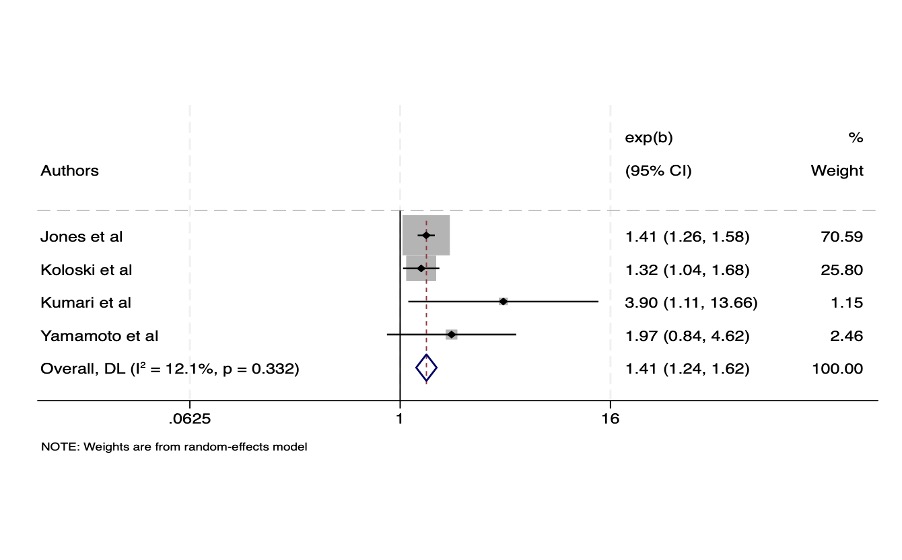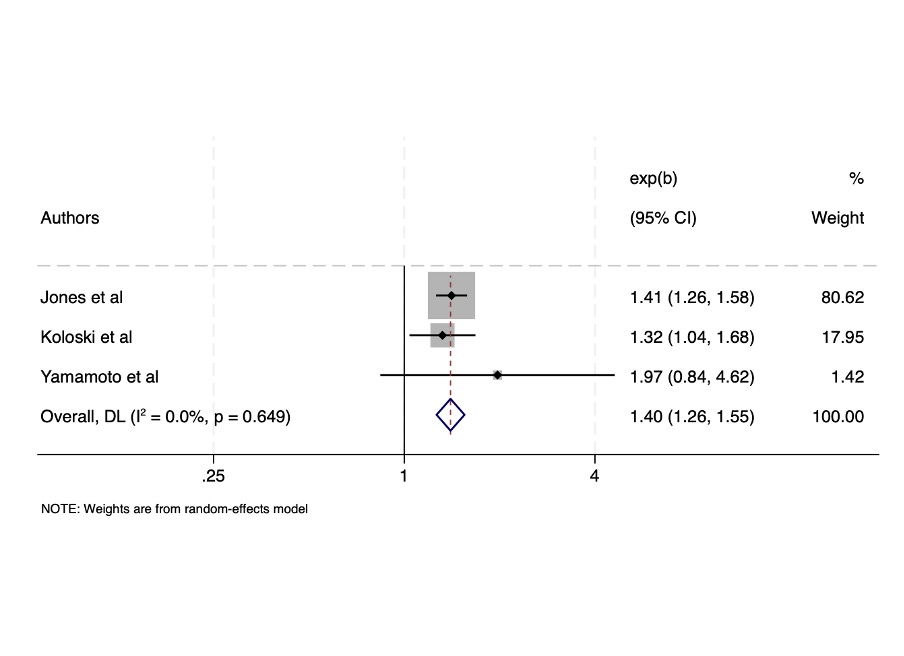Monday Poster Session
Category: Functional Bowel Disease
P2917 - Unwinding the Relationship Between Functional Dyspepsia and Asthma: A Systematic Review and Meta-analysis
Monday, October 27, 2025
10:30 AM - 4:00 PM PDT
Location: Exhibit Hall

Gedion Yilma Amdetsion, MD (he/him/his)
Cook County Health
Chicago, IL
Presenting Author(s)
Gedion Yilma Amdetsion, MD1, Chun-wei Pan, MD1, Hiwot G. Tebeje, MD, MPH2, Michael G. Tebeje, MD, MPH3, Jose B. Saenz, MD, PhD4
1Cook County Health, Chicago, IL; 2Washington University in St. Louis, Saint Louis, MO; 3Washington University in St. Louis, St. Louis, MO; 4Washington University School of Medicine in St. Louis, St. Louis, MO
Introduction: Functional dyspepsia (FD) affects ~7.2% of the global population and 12% of U.S. adults. Though the symptoms of FD (defined by Rome IV criteria as epigastric pain, burning, postprandial fullness, or early satiation without structural disease) are protean, the pathophysiology behind this common disease remains unclear. Some evidence suggests that FD exhibits a dual Th17 effector memory and Th2 signature in the duodenum. Given parallels with Th2-driven hypersensitivity seen in asthma, we evaluated the association between asthma and FD.
Methods: Following PRISMA guidelines, we searched PubMed, Scopus, and Web of Science (inception–April 1, 2025) for human cohort or cross-sectional studies that reported odds ratios (ORs) or hazard ratios (HRs) with 95% CIs for asthma and FD. We excluded case reports, reviews, guidelines, commentaries, and editorials. Data on study design, sample size, effect estimates, and adjustments for confounders were extracted. A random effects meta-analysis pooled effect sizes; heterogeneity (Q, I², τ²), trim and fill, and Egger’s tests assessed for robustness and publication bias.
Results: Of 136 records identified, 104 remained after deduplication, with 4 studies (total n = 37,037) meeting inclusion criteria. Metaanalysis yielded a significant positive association between asthma and FD (pooled OR 1.414; 95% CI 1.236–1.618; p < 0.001) with low heterogeneity (Q = 3.41, df = 3, p = 0.332; I² = 12.1%; τ² = 0.0034), excluding the single pediatric cohort (Kumari et al.) that produced a similar estimate (OR 1.400; 95% CI 1.265–1.550; p < 0.001; Q = 0.86, df = 2, p = 0.649; I² = 0%). Trim and fill analysis showed negligible changes(observed OR 1.409 vs. imputed OR 1.393), and Egger’s test was nonsignificant (p = 0.149), indicating minimal publication bias.
Discussion: This meta-analysis demonstrates a modest but significant association between asthma and FD. While causality cannot be established, shared Th2/Th17 immunopathogenesis could underpin this co-morbidity. It remains to be seen whether clinicians should screen for asthma symptoms in functional dyspepsia. Future large-scale, longitudinal studies and clinical trials targeting Th2/Th17 pathways are warranted to assess whether optimized asthma control can alleviate FD and to identify FD subtypes most linked to allergic mechanisms.

Figure: Fig. 1 . Forrest plot of studies showing relationship between asthma and functional dyspepsia

Figure: Fig.2 Leave one out sensitivity analysis
Disclosures:
Gedion Yilma Amdetsion indicated no relevant financial relationships.
Chun-wei Pan indicated no relevant financial relationships.
Hiwot Tebeje indicated no relevant financial relationships.
Michael Tebeje indicated no relevant financial relationships.
Jose Saenz indicated no relevant financial relationships.
Gedion Yilma Amdetsion, MD1, Chun-wei Pan, MD1, Hiwot G. Tebeje, MD, MPH2, Michael G. Tebeje, MD, MPH3, Jose B. Saenz, MD, PhD4. P2917 - Unwinding the Relationship Between Functional Dyspepsia and Asthma: A Systematic Review and Meta-analysis, ACG 2025 Annual Scientific Meeting Abstracts. Phoenix, AZ: American College of Gastroenterology.
1Cook County Health, Chicago, IL; 2Washington University in St. Louis, Saint Louis, MO; 3Washington University in St. Louis, St. Louis, MO; 4Washington University School of Medicine in St. Louis, St. Louis, MO
Introduction: Functional dyspepsia (FD) affects ~7.2% of the global population and 12% of U.S. adults. Though the symptoms of FD (defined by Rome IV criteria as epigastric pain, burning, postprandial fullness, or early satiation without structural disease) are protean, the pathophysiology behind this common disease remains unclear. Some evidence suggests that FD exhibits a dual Th17 effector memory and Th2 signature in the duodenum. Given parallels with Th2-driven hypersensitivity seen in asthma, we evaluated the association between asthma and FD.
Methods: Following PRISMA guidelines, we searched PubMed, Scopus, and Web of Science (inception–April 1, 2025) for human cohort or cross-sectional studies that reported odds ratios (ORs) or hazard ratios (HRs) with 95% CIs for asthma and FD. We excluded case reports, reviews, guidelines, commentaries, and editorials. Data on study design, sample size, effect estimates, and adjustments for confounders were extracted. A random effects meta-analysis pooled effect sizes; heterogeneity (Q, I², τ²), trim and fill, and Egger’s tests assessed for robustness and publication bias.
Results: Of 136 records identified, 104 remained after deduplication, with 4 studies (total n = 37,037) meeting inclusion criteria. Metaanalysis yielded a significant positive association between asthma and FD (pooled OR 1.414; 95% CI 1.236–1.618; p < 0.001) with low heterogeneity (Q = 3.41, df = 3, p = 0.332; I² = 12.1%; τ² = 0.0034), excluding the single pediatric cohort (Kumari et al.) that produced a similar estimate (OR 1.400; 95% CI 1.265–1.550; p < 0.001; Q = 0.86, df = 2, p = 0.649; I² = 0%). Trim and fill analysis showed negligible changes(observed OR 1.409 vs. imputed OR 1.393), and Egger’s test was nonsignificant (p = 0.149), indicating minimal publication bias.
Discussion: This meta-analysis demonstrates a modest but significant association between asthma and FD. While causality cannot be established, shared Th2/Th17 immunopathogenesis could underpin this co-morbidity. It remains to be seen whether clinicians should screen for asthma symptoms in functional dyspepsia. Future large-scale, longitudinal studies and clinical trials targeting Th2/Th17 pathways are warranted to assess whether optimized asthma control can alleviate FD and to identify FD subtypes most linked to allergic mechanisms.

Figure: Fig. 1 . Forrest plot of studies showing relationship between asthma and functional dyspepsia

Figure: Fig.2 Leave one out sensitivity analysis
Disclosures:
Gedion Yilma Amdetsion indicated no relevant financial relationships.
Chun-wei Pan indicated no relevant financial relationships.
Hiwot Tebeje indicated no relevant financial relationships.
Michael Tebeje indicated no relevant financial relationships.
Jose Saenz indicated no relevant financial relationships.
Gedion Yilma Amdetsion, MD1, Chun-wei Pan, MD1, Hiwot G. Tebeje, MD, MPH2, Michael G. Tebeje, MD, MPH3, Jose B. Saenz, MD, PhD4. P2917 - Unwinding the Relationship Between Functional Dyspepsia and Asthma: A Systematic Review and Meta-analysis, ACG 2025 Annual Scientific Meeting Abstracts. Phoenix, AZ: American College of Gastroenterology.
